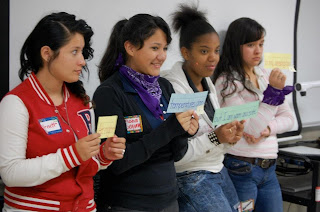Getting your kids highly engaged in a secondary English class is hard, but it can be done! This year, helping kids who needed acceleration demanded that I find ways to get them engaged and keep them engaged.
Typically kids who struggle in English think differently. Often [but certainly not always] they are good at spatial organization and they are kinesthetic learners. They don't like to sit and read and talk and write. They want to move, touch, organize, and think.
That's a tough learning-style to tap into, so here's how I have successfully used manipulatives.
In the fall, I organized and planned for Camp Onomatopoeia--a 2-Saturday writing camp to help retesting kids. Camp O focused on writing, so it offered lessons in essay planning, revision, and grammar. [Those are all lessons guaranteed to bring any teacher to her knees, so I promise to blog about them in the future.]
Flying at 10,000 feet, here is what the revision session looked like. This is just about the simplest way to use manipulatives, and really...it was more cutesy than anything. The brain does love novelty though, and this lesson was lots of fun for both teachers and kids. I took simple sentences [The fish was big. There were so many stars in the sky. The marshmallow was sticky.] and cut them out and stuck them to little die cut fishies. Students were then given strategies to develop those sentences with way more detail and then they wrote them on the bigger fish. I really wish my big fish matched my little fish just a bit more, but hey...go with what works. These were fun finished products to post in the hall.
 |
| Camp Onomatopoeia--"Gone Fishin'" A Lesson in Revision |
 |
| Camp Onomatopoeia--"Sentence Trails" Whole Group Lesson |
During that same session, I broke them into small groups and had them play with smaller maniuplatives at their desks. The packet of maniuplatives included independent clauses, dependent clauses, FANBOYS [coordinating conjunctions], and AAAWWWUUBBIS words [subordinate conjunctions]. For 5 minutes, I'd tell them to make compound sentences. Then for another 5 minutes, I'd tell them to make complex sentences. If you give the kids a vis-a-vis marker, they can even add in the appropriate punctuation and clean up the desks later.
Here are a few nitty-gritty details to help you keep your sanity while you work on the art of manipulation:
- Spell check does not recognize the word "manipulatives". It's annoying. Just get used to it telling you that you are wrong. [But you know inside that you're right because I said so.]
- Color-code them!! When you find the random word "because" laying on your floor and you're not quite sure who it belongs to, it is WAAAAAAY easier to find your green group [and give them the ugly teacher face for losing materials] than it is to reconcile each group's manipulative envelope.
- Keep them in resealable envelopes. Suzanne and I
stealborrow these from the office downstairs on a regular basis because they've got cool little brads for closing. - Finally, when you're done, bundle them together with a rubber band and label the bundle. The one in the picture even reminds me that it is camp themed. Trust me...once you get cranking on these bad boys, you'll want good record-keeping.

Good luck perfecting the art of manipulation and student engagement!



No comments